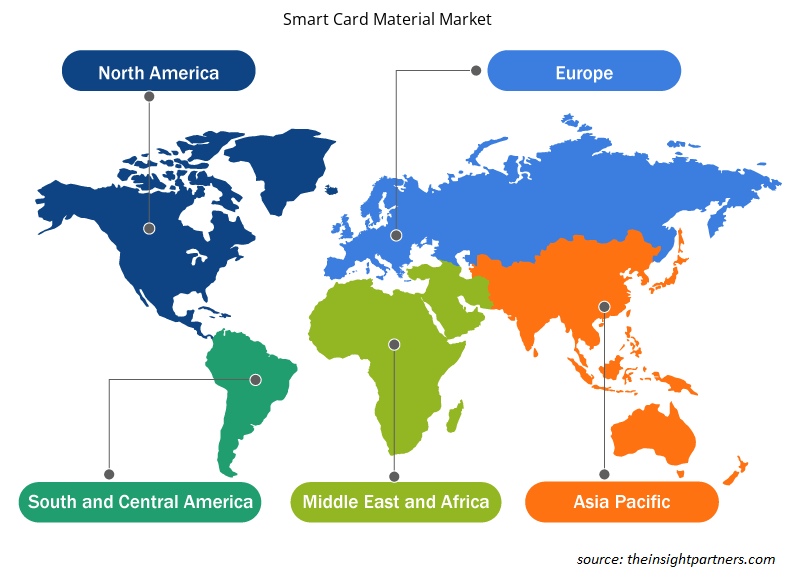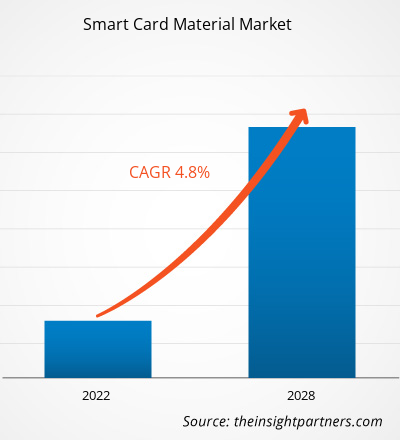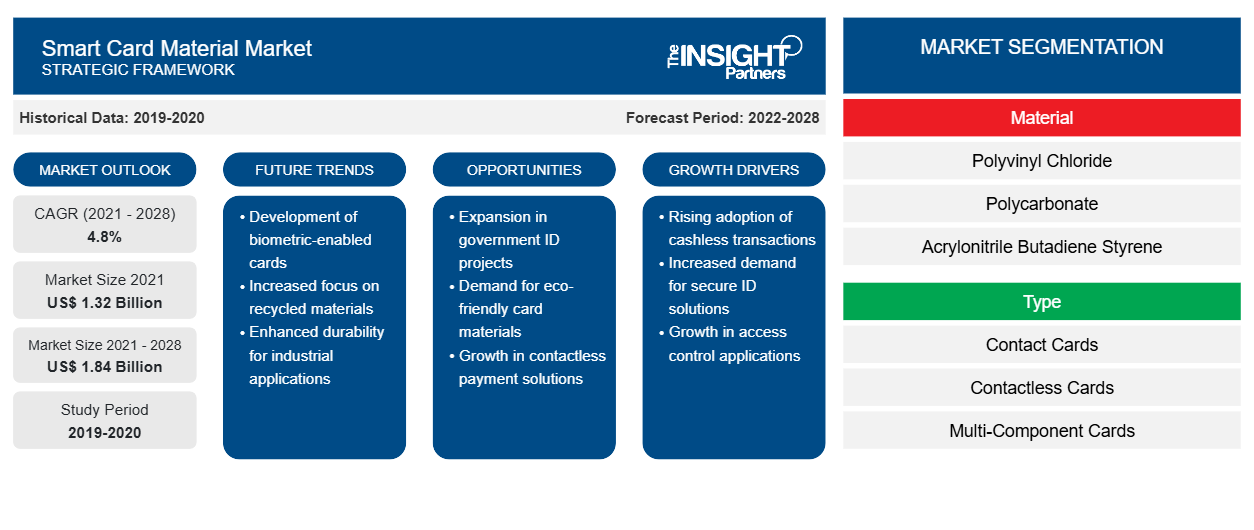スマートカード材料市場は、2021年の13億2,457万米ドルから2028年には18億3,778万米ドルに達すると予測されており、2021年から2028年にかけて4.8%のCAGRで成長すると予想されています。CAGR of 4.8% from 2021 to 2028.
スマート カードはチップ カードの一種で、データの保存と処理を行うメモリまたはマイクロプロセッサ タイプのコンピュータ チップが組み込まれたプラスチック カードです。このデータは通常、チップ内で保存および処理される値または情報、またはその両方に関連付けられています。スマート カードの素材とは、これらのカードの製造に使用される化学物質を指します。これらの素材は、情報の埋め込みと印刷をサポートします。
2020年、アジア太平洋地域は世界のスマートカード材料市場で最大のシェアを占めました。この地域のスマートカード材料の需要は、通信分野でのスマートカードの使用の増加により増加しています。さらに、グローバル化の傾向の高まり、銀行、金融サービス、保険(BFSI)業界の急増は、この地域のスマートカード材料市場の成長を促進する重要な要因です。BFSI) industry are key factors favoring the smart card material market growth in the region.
要件に合わせてレポートをカスタマイズする
このレポートの一部、国レベルの分析、Excelデータパックなど、あらゆるレポートを無料でカスタマイズできます。また、スタートアップや大学向けのお得なオファーや割引もご利用いただけます。
-
このレポートの主要な市場動向を入手してください。この無料サンプルには、市場動向から見積もりや予測に至るまでのデータ分析が含まれます。
COVID-19パンデミックがスマートカード材料市場に与える影響
現在進行中のCOVID-19パンデミックは、化学および材料セクターの状況を大幅に変え、スマートカード材料市場の成長に影響を与えました。いくつかの産業セクターのパフォーマンスの大幅な低下は、スマートカード材料の需要に影響を与えています。パンデミックの影響は、さまざまなアプリケーションセグメントによって異なります。データトラフィックと音声サービスの急増は、ブロードバンドおよびモバイルデータセンターオペレーターを含む多くの通信プレーヤーに利益をもたらしました。ただし、政府によって課されたロックダウン措置により、スマートカード製造に必要なPVS、ABS、PETGなどの原材料のサプライチェーンが混乱しました。病気の蔓延は、政府およびBFSIセクターの業務に悪影響を及ぼしました。ただし、経済が事業の復活を計画しているため、今後数年間でスマートカード材料の需要は世界的に増加すると予想されます。
市場分析
通信およびヘルスケア分野で大幅な成長
スマート カードは、電気通信分野で広く使用されています。この分野でスマート カードが最もよく使用されているのは、加入者識別モジュール (SIM) カードまたはユニバーサル集積回路カード (UICC) です。これらのスマート カードは、主にポリ塩化ビニル (PVC) とアクリロニトリル ブタジエン スチレン (ABS) 材料で製造されています。この分野のアプリケーションで使用されるスマート カード技術は、過去数年間で継続的に進歩しており、これらのカードの消費量が増加しています。さらに、世界中のヘルスケア組織が、幅広い機能とアプリケーションを備えたスマート ヘルス カードを導入しています。
スマートカード材料市場の地域別洞察
予測期間を通じてスマート カード材料市場に影響を与える地域的な傾向と要因は、Insight Partners のアナリストによって徹底的に説明されています。このセクションでは、北米、ヨーロッパ、アジア太平洋、中東、アフリカ、南米、中米にわたるスマート カード材料市場のセグメントと地理についても説明します。

- スマートカード材料市場の地域別データを入手
スマートカード材料市場レポートの範囲
| レポート属性 | 詳細 |
|---|---|
| 2021年の市場規模 | 13億2千万米ドル |
| 2028年までの市場規模 | 18億4千万米ドル |
| 世界のCAGR(2021年~2028年) | 4.8% |
| 履歴データ | 2019-2020 |
| 予測期間 | 2022-2028 |
| 対象セグメント |
素材別
|
| 対象地域と国 |
北米
|
| 市場リーダーと主要企業プロフィール |
|
スマートカード材料市場のプレーヤー密度:ビジネスダイナミクスへの影響を理解する
スマート カード マテリアル市場は、消費者の嗜好の変化、技術の進歩、製品の利点に対する認識の高まりなどの要因により、エンド ユーザーの需要が高まり、急速に成長しています。需要が高まるにつれて、企業は提供品を拡大し、消費者のニーズを満たすために革新し、新たなトレンドを活用し、市場の成長をさらに促進しています。
市場プレーヤー密度とは、特定の市場または業界内で活動している企業または会社の分布を指します。これは、特定の市場スペースに、その市場規模または総市場価値に対してどれだけの競合相手 (市場プレーヤー) が存在するかを示します。
スマートカード材料市場で事業を展開している主要企業は次のとおりです。
- イーストマンケミカルカンパニー
- ペトロチャイナ株式会社
- ソルベイSA
- ケムワン
- サビック
免責事項:上記の企業は、特定の順序でランク付けされていません。

- スマートカード材料市場のトップキープレーヤーの概要を入手
アプリケーションインサイト
用途に基づいて、スマートカード材料市場は、BFSI、政府、通信、小売、ヘルスケア、ホスピタリティ、その他に分類されます。 2020年には、通信セグメントがスマートカード材料市場で最大のシェアを占めました。 スマートカードは、プリペイド(ストアードバリューメモリカード)電話カードや、携帯電話のマイクロプロセッサスマートカードベースのSIMカードまたはUICCとして使用されます。 この分野で最も売れているスマートカード製品は、量と価値の点から見て、SIMとUICCです。
世界のスマートカード材料市場で事業を展開している企業としては、Eastman Chemical Company、PetroChina Company Limited、Solvay SA、KEM ONE、SABIC、3A Composites GmbH、Teijin Limited、LG Chem、BASF SE、Westlake Chemical Corporation などがあります。
レポートの注目点
- スマートカード材料市場における進歩的な業界動向は、プレーヤーが効果的な長期戦略を策定するのに役立ちます。
- 先進国市場と発展途上国市場で事業を展開する企業が採用する事業成長戦略
- 2019年から2028年までのスマートカード材料市場の定量分析
- スマートカード材料の世界需要の推定
- 業界で活動するバイヤーとサプライヤーの有効性を示すポーターの5つの力の分析
- 競争市場の状況を理解するための最近の動向
- スマートカード材料市場の成長を牽引・抑制する要因と市場動向と展望
- 商業的利益を支える市場戦略を強調することで意思決定プロセスを支援し、スマートカード材料市場の成長につながる
- さまざまなノードにおけるスマートカード材料市場規模
- 市場の詳細な概要とセグメンテーション、およびスマートカード材料業界の動向
- 有望な成長機会のあるさまざまな地域におけるスマートカード材料市場の規模
スマートカード材料市場
素材別
- ポリ塩化ビニル(PVC)
- ポリカーボネート(PC)
- アクリロニトリルブタジエンスチレン(ABS)
- ポリエチレンテレフタレートグリコール(PETG)
- その他
タイプ別
- 連絡先カード
- 非接触型カード
- マルチコンポーネントカード
アプリケーション別
- 英国
- 政府
- 通信
- 小売り
- 健康管理
- ホスピタリティ
- その他
企業プロフィール
- イーストマンケミカルカンパニー
- ペトロチャイナ株式会社
- ソルベイSA
- ケムワン
- サビック
- 3Aコンポジット株式会社
- 帝人株式会社
- LG化学
- BASF SE
- ウェストレイクケミカルコーポレーション
- 過去2年間の分析、基準年、CAGRによる予測(7年間)
- PEST分析とSWOT分析
- 市場規模価値/数量 - 世界、地域、国
- 業界と競争環境
- Excel データセット
最新レポート
お客様の声
購入理由
- 情報に基づいた意思決定
- 市場動向の理解
- 競合分析
- 顧客インサイト
- 市場予測
- リスク軽減
- 戦略計画
- 投資の正当性
- 新興市場の特定
- マーケティング戦略の強化
- 業務効率の向上
- 規制動向への対応























 無料サンプルを入手 - スマートカード材料市場
無料サンプルを入手 - スマートカード材料市場